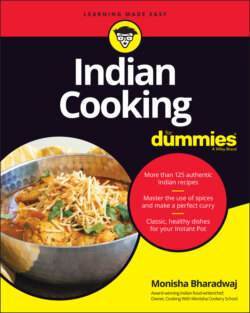Читать книгу Indian Cooking For Dummies - Monisha Bharadwaj - Страница 56
A spice tin for storing spices
ОглавлениеTo make your cooking really easy and to feel like an expert Indian cook, treat yourself to a spice tin (or masala dabba). They’re usually round, made of stainless steel, with seven small bowls that fit snugly inside (see Figure 3-5). Some have a double lid to seal in the freshness. With a proper spice tin, you’ll have your favorite spices on hand just with the opening of one lid.
Photograph by Wendy Jo Peterson and Geri Goodale
FIGURE 3-5: A spice tin.
You’ll find lots of different spice tins on the market, made of metal or plastic. You can even find fancy wooden ones. I prefer a steel spice tin, because they’re easy to wash, won’t get stained, and don’t absorb the flavors of the spices. Choose a size that fits your kitchen and needs, but don’t worry too much about the size — you’ll be refilling your tin from time to time anyway.
Don’t overlook the lid when you’re choosing a spice tin. Lids vary, and the wrong lid, made of glass or clear plastic, could mean the slow demise of your spices, which like to live in dark, dry conditions. Choose an opaque lid instead.
Most spice tins come with a small spice spoon, but if yours doesn’t, buy one. A regular teaspoon won’t fit easily into the small bowls. You can use the same spoon for all the spices, but if you’re fussy, sets of small, stainless-steel spice spoons are also available.
Here are some tips on using your new friend in the kitchen:
Choose your spices. Spice tins around India contain a varying mix of spices depending on the regional cuisine. Fill your tin with whatever you use most. My essential spices are black mustard seeds, cumin seeds, ground cumin, ground coriander, turmeric, medium-hot chile powder, and garam masala.
Fill your tin. Buy small packs of spices and use them up quickly so your stock remains fresh. Decant the spices into your spice tin, and seal and store the remainder in a dark, dry cupboard. Refill your tin as and when necessary, but fill each bowl only three-quarters full, or you’ll end up with a mess.
Keep your spices fresh. Spices like to stay dry. When adding them into your pan while cooking, just tip a spoonful in and resist the temptation to do an artistic sprinkle. The longer you hold your spice spoon over a steaming pot, the more the moisture it will bring back to the tin, making your spices clumpy.
Bring your tin to the stovetop, and hold it in one hand as you add spices with the other. This will reduce spillage (think of those little mustard seeds that might escape), and you’ll have the next spice on hand, if they’re going into the pan in a sequence. If you think you need to practice spooning out your spices neatly, mix them in a small bowl before you begin cooking. Remember to only mix those that go into the pan at the same time, so seeds and powders will have to be kept separate (see Chapter 8).
Clean your tin regularly. You’ll notice that the tin gets a bit grungy after a few uses. Lift out the little bowls and give the tin a good wipe with clean paper towel. Once in a while, you can tip the spices into other bowls and give the whole tin a good wash. Dry it completely before reintroducing the spices.
